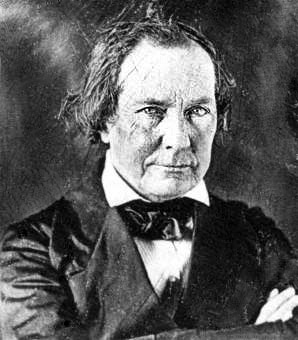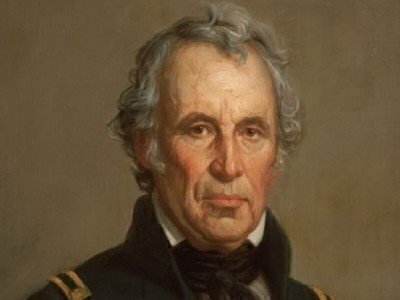It started with the Texas War of Independence in 1836, at the end of which the Republic of Texas became a nation and the Mexican army withdrew (for more on the war, read Remember (My Visit To) The Alamo! series, and Sam Houston: The Raven). The treaty signed by Santa Anna left the boundaries of Texas ill-defined and the refusal of Mexico, after Santa Anna's removal from office, to ratify the treaty and recognize Texas as an independent nation created an unstable situation where Texas was both expansionist and constantly worried about the prospects of another Mexican invasion.
Most Texians asserted that their country's western boundary extended to the Rio Grande and encompassed all of present day New Mexico and Colorado east of that river.
(From wikipedia)

Initially the situation was contained by the Republic's first President, Sam Houston, who did not press boundary issues and followed a policy of reconciliation with Mexico as well as with the powerful Indian tribes in the area. Limited to one term by the Republic's constitution, Houston was succeeded in December 1838 by Mirabeau Lamar who was elected to a three year term. Lamar's policy was of aggressive expansion, hostility to Mexico, and undertaking of punitive expeditions against the tribes, prompting retaliation against settlers.
All of this was against a confusing situation in the new nation of Mexico, which had achieved independence from Spain in 1821. Although its 1824 Constitution was federalist, the instability, and frequent turnover of governments in Mexico City, along with the ascension of centralizers, like Santa Ana, led to unrest in many parts of the country and, in particular, in the northern border territories and states. California, Sonora, and New Mexico all saw revolts in the 1830s. In January 1840 Federalist leaders in Nuevo Leon, Coahuila, and Tamaulipas, meeting in Laredo, declared independence and the creation of the Republic of the Rio Grande. Although the central government soon suppressed the rebellion its leaders fled into Texas from which they launched another unsuccessful revolt. Though Texas remained officially neutral, it did provide support to the Yucatan in its war for independence from 1840 to 1846.
Texas itself was a ramshackle country; the national government was broke and civil organization minimal at any level. The entire western half of the country was off limits to Anglo settlers because of the Comanche threat and, on occasion, the Comanche raided deep into Texas. In 1840 a late raid actually reached the Gulf Coast mid-way between Corpus Christi and Houston.
That same year Lamar appointed three Texians living in Santa Fe as commissioners and sent them a letter they could use to invite the people of Neuvo Mexico, then part of Mexico, to join the Republic of Texas. The overture was not successful and the following year, Lamar decided to send an expedition to Santa Fe, despite the opposition of the Texas Congress. The expedition was to be initially presented to New Mexico authorities as for the purpose of commerce but its real purpose was to seize control of the lucrative trade of the Santa Fe Trail and to annex New Mexico. Lamar's deception was fairly obvious as the "trading" expedition was accompanied by five companies of infantry and one of artillery under the command of General Hugh McLeod, a West Point graduate.
(Mirabeau Lamar, from wikipedia)

Three hundred and twenty one men set out from Austin in June 1841. They had little knowledge of the route to Santa Fe, at one point mistaking the Wichita River for the Red River and following it in the wrong direction for twelve days. Food supplies ran low and they lacked sufficient water. One attack by Kiowas killed five soldiers, while another attack resulted in the expedition losing all its cattle and a large number of horses. These troubles were exacerbated by the desertion of their two Mexican guides who made way to Taos where they warned Governor Manual Armijo of the approaching Texians.
Armijo quickly mobilized more than 1,000 soldiers and advanced east, surrounding the main body of hungry, weary and thirsty Texians near Tucumcari. McLeod and his men surrendered on October 5, without firing a shot. Over the next ten weeks the prisoners were marched to El Paso, then to Mexico City, and finally imprisoned in Veracruz.
Lamar's tenure, which ended in December 1841 was a disaster between the failure of his Mexico policy, the wars caused by his Indian policy and the decrepit finances of the Republic. After annexation, Lamar served in the state legislature and was appointed by President Buchanan as minister to Nicaragua and later Costa Rica before dying in 1859.
The US minister to Mexico intervened on behalf of the prisoners and was able to obtain their release in April 1842. After his release, Hugh McLeod served in the Texas legislature and married a cousin of Mirabeau Lamar. A fierce opponent of Sam Houston (for a quarter century Texas politics was about whether you were for or against Houston) McLeod joined the Confederacy, serving as colonel in Hood's Texas Brigade before dying of pneumonia in Virginia in early 1862.
In the meantime tensions between Mexico and Texas exploded. In March 1842, Mexican troops occupied Goliad, Victoria, and San Antonio causing panic across Texas. Though the occupation forces soon retreated, San Antonio was reoccupied by the Mexicans for several days in September. Sam Houston, reelected president in December 1841, order a punitive expedition towards the Rio Grande, apparently more to appease Texian public opinion than to engage in pitched battles. After capturing Laredo the expedition's commander ordered a retreat but more than 300 Texians refused and, under the leadership of political opponents of Houston, decided to cross the Rio Grande. They were defeated in a battle near the town of Meir with thirty killed and the rest captured.
While being marched to Mexico City, the Texians made a mass escape eluding capture for seven days. An enraged Santa Anna (president, once again) ordered their execution. The Governor of the state of Coahuila refused to obey the order which was finally modified to require the execution of every tenth man, to be determined by the drawing of lots. On March 25, 1843 seventeen of the prisoners were shot. Many of the survivors died in prison while others were released from time to time, with the last obtaining their freedom in September 1844.
Meanwhile, Texas made two additional attacks on Nuevo Mexico in 1843. Charles Warfield, fur trapper and Texas army officer, led 24 men in a retaliatory campaign, attempting to seize Mora, New Mexico (northeast of Santa Fe). Driven off, his band later murdered Mexican trader Antonio Jose Chavez, on the Santa Fe Trail.
This was followed in the same year by an expedition of 200 men led by James Snively, quartermaster of the Texas army, to attack Mexican merchants on the Santa Fe Trail and, if possible, seize the town. In June, Snively's band defeated a unit of Mexican soldiers. However, their was broad dissatisfaction with Snively among his men and the command voted to divide itself. Several days later Snively's command unexpectedly encountered a troop U.S. Army Dragoons under Capt Philip St George Cooke which had been sent to protect Mexican caravans on the trail after the killing of Chavez. Cooke informed Snively he was on American territory Though Snively protested he was on Texas territory, Cooke surrounded the Texan camp and disarmed the men, ending the expedition.
Phil Cooke was a noted Indian fighter, and served under George McClellan was a cavalry commander during the Peninsula Campaign in 1862. He was removed and sent to non-combat posts, in part because of the army's humiliation when Cooke's son-in-law, Jeb Stuart led his cavalry command on a successful ride around the entire Union Army. You can still buy Cooke's memoirs on Amazon:

Snively went on to join the California Gold Rush in 1849, moving on to the Arizona Territory in 1858 where he played a role in organizing Yuma County while continuing to prospect. He eventually settled in the Phoenix area and was killed by Apaches while exploring near Wickenburg, Arizona in 1871.
In 1845, Texas agreed to be annexed by the United States but it was not the end of its aspirations to expand its border westwards. The following year General Philip Kearny seized Nuevo Mexico which became part of the United States with the end of the Mexican War in 1848. Texas continued to assert that its western boundary was on the Rio Grande, actually sending a commission to organize Santa Fe County under Texas Law, prompting local citizens to file a petition with the American government to allow New Mexico to be organized as a territory.
New Mexico now became part of the greater crisis over slavery that engulfed the Union. With the legal status of slavery in both California and New Mexico in question and Texan claims regarding borders the situation once again became explosive.
In March 1849, President Zachary Taylor took office. Taylor, hero of the Mexican War and Louisiana slave owner was expected to look favorably on the expansion of the peculiar institution but, to the South's surprise and outrage, Taylor proved a fierce opponent to slavery's expansion into the territories. To end the dispute, President Taylor urged the citizens of California and New Mexico to draft constitutions, apply for statehood, and avoid becoming territories.
(President Taylor, from constitutioncenter.org)

Tempers grew hotter. Texans who favored both territorial and slavery expansion began to agitate to secure their Rio Grand boundaries by force, with the Governor of Texas threatening to send troops to Santa Fe, as well as threatening secession. In February 1850 Taylor met with Southern leaders and warned them that anyone "taken in rebellion against the Union, he would hang ... with less reluctance than he had hanged deserters and spies in Mexico." He ordered reinforcement of U.S. Army garrisons in New Mexico and instructed that any attempt by Texas to assert its claims to New Mexico be met with force.
Taylor began writing a message to Congress about the crisis but never finished it. After an Independence day ceremony and picnic at the White House, the president fell ill, dying five days later. His successor Millard Fillmore, was a much less formidable character, and Congress reasserted itself eventually passing a series of measures that became known as the Compromise of 1850. The first bill passed, on September 9, was the Texas and New Mexico Act which established the current boundaries of Texas, made New Mexico a territory and allowed it to choose whether to be slave or free when it became a state (which did not happen until 1912), and provided that the United States would pay off $10 million of the debts of the Republic of Texas (which had teetered on the edge of bankruptcy throughout its nine years of independence).
With that the dispute between New Mexico and Texas came to a close.
Though with those Texans you can never be sure.
No comments:
Post a Comment